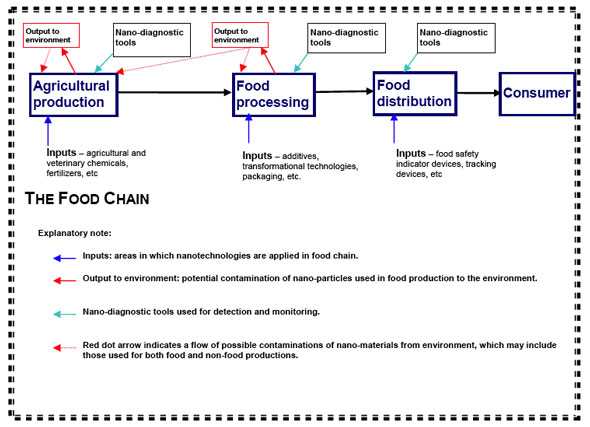| Posted: November 28, 2008 |
Food safety implications of nanotechnology on agenda of World Health Organization and FAO |
|
(Nanowerk News) The Food and Agriculture Organization of the United Nations (FAO) and the World Health Organization (WHO) have recognized a need for scientific advice on any food safety implications that may arise from the use of nanotechnologies in the food and agriculture sectors through its horizon scanning activities.
|
|
Given the increased global interest in the use of nanotechnology and concerns on the potential food safety implications, FAO and WHO have planned to convene a joint Expert Meeting which aims to identify knowledge gaps including issues on food safety, review current risk assessment procedures, consequently support further food safety research and develop global guidance on adequate and accurate methodologies to assess potential food safety risks that may arise from nanoparticles.
|
|
The meeting – Joint FAO/WHO Expert Meeting on the Application of Nanotechnologies in the Food and Agriculture Sectors: Potential Food Safety Implications – will be held on June 1-5, 2009, at FAO Headquarters, Rome, Italy.
|
|
Scope
|
|
The scope of the Expert Meeting should cover actual and anticipated nanotechnologies applied in the food and agriculture sectors, with particular attention to:
|
|
The application of nanotechnologies in all aspects of the primary production of foods of plant and animal origin;
The application of nanotechnology in food processing, packaging and distribution; and
The use of nano-diagnostic tools for detection and monitoring in food and agriculture production.
|
|
Nanotechnologies applied in the environment may also be included if there is a potential direct impact on food safety through the environment to food chain.
The Expert Meeting will NOT cover occupational health matters surrounding the use and application of nanotechnologies in the food and agriculture sectors, although these issues may be noted for further consideration elsewhere.
|
 |
| Diagram on potential applications of nanotechnologies through a food chain from primary food production to consumption, which may require considerations on food safety aspects aimed at protecting the health of consumers.
|
|
Objectives
|
|
The overall purpose of the Expert Meeting is to provide member countries with comprehensive information on what is currently known about potential food safety risks, to identify priority areas of work required to better assess these risks and to advise on ways to promote transparent and constructive dialogue among stakeholders.
|
|
To this respect, the objectives of the Expert Meeting should be:
|
|
to take stock of actual and anticipated applications of nanotechnologies in the food and agriculture sectors;
to identify potential food safety implications associated with actual and anticipated applications of nanotechnologies in the food and agriculture sectors;
to determine the need for additional tools or metrics and to identify any data requirements and research gaps;
to consider the application of current risk assessment methodologies to evaluate the safety of nanomaterials used in the food chain;
to identify priority areas for which scientific advice should be requested from FAO/WHO in accordance with their Joint framework for the provision of scientific advice; and
to advise on ways and means of fostering transparent and trustful dialogue among all stakeholders.
|
|
Expected outputs
|
|
The Expert Meeting will:
|
|
provide information on existing and emerging applications of nanotechnologies, which includes what is known about the food safety implications as well as any potential risks including present capacity to assess such risk;
formulate (or recommend) a medium term plan of further work that may be required to accurately assess those risks; and
provide an analysis of efforts that have been made in various countries to promote communication among stakeholders and advise on ways and means of facilitating transparent and constructive dialogue.
|

